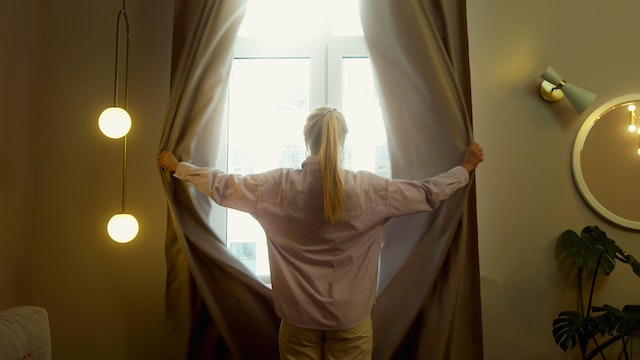Imagine breathing in the clean, fresh air every time you step into your health and home. Sounds wonderful, doesn’t it? Indoor air quality plays a crucial role in our overall health, and with most people spending a significant portion of their time indoors, it’s essential to make sure the air we breathe is as pure as possible.
This post explores nine ways to improve indoor air quality, safeguard your health, and create a more comfortable living environment.
1. Maintain Proper Ventilation:
Proper airflow helps to remove stale air, reduces humidity, and minimizes the concentration of indoor pollutants, ensuring good indoor air quality. One simple way to improve ventilation is to open windows and doors whenever possible, allowing fresh air to circulate throughout your home. Using exhaust fans in areas prone to high moisture, such as bathrooms and kitchens, can also help keep humidity in check and prevent mold growth.
For a more advanced solution, consider installing an energy recovery ventilator (ERV). ERVs exchange stale indoor air with fresh outdoor air while recovering energy to maintain your home’s temperature. This option ensures your home remains well-ventilated without compromising comfort or energy consumption.
2. Be Mindful of Asbestos Exposure:
Asbestos, a mineral once widely used in construction materials, can pose serious health risks when inhaled. Exposure to asbestos fibers can lead to mesothelioma, a rare form of cancer. Although the use of asbestos has been significantly restricted, it can still be found in some older homes. It’s essential to be aware of the potential dangers and take necessary precautions to minimize exposure.
If you suspect your home may contain asbestos, have a professional inspect and test for its presence. If asbestos is found, take proper abatement measures to ensure safety.
If you or a loved one has been diagnosed with mesothelioma due to asbestos exposure, consider consulting a reputable firm of mesothelioma lawyers for legal advice and potential compensation.
3. Keep Your Home Clean:
Regular cleaning is essential for maintaining a healthy home. Dust, pollen, pet dander, and other allergens accumulate on surfaces, negatively impacting indoor air quality. Make it a habit to dust and vacuum your home at least once a week, focusing on areas that tend to collect the most dust, such as carpets, upholstery, and curtains. A vacuum cleaner with a HEPA filter can help capture even the smallest particles, further improving indoor air quality.
A clutter-free home is not only visually appealing but also easier to clean. Removing unnecessary items and keeping surfaces tidy can prevent dust buildup and make cleaning more manageable. You can use washable rugs or mats to trap dirt and debris in high-traffic areas. Regularly wash these floor coverings to keep your home cleaner and your air fresher.
4. Use Air Purifiers:
Air purifiers can significantly improve indoor air quality, especially for those who suffer from allergies or respiratory issues. When selecting an air purifier, consider one with a HEPA filter designed to capture particles as small as 0.3 microns. These filters are particularly effective at removing allergens and pollutants from the air. Some air purifiers also include activated carbon filters, which can help eliminate odors and volatile organic compounds (VOCs) from the air.
For the best results, place air purifiers in rooms where you spend the most time, such as bedrooms and living areas. Keep in mind that larger rooms may require more powerful air purifiers or multiple units for optimal air cleaning. Remember to change or clean the filters regularly, following the manufacturer’s recommendations to maintain peak performance.
5. Control Humidity Levels:
High humidity levels can create an ideal breeding ground for mold, mildew, and dust mites, all of which can negatively impact indoor air quality and exacerbate allergies and asthma. Aim to maintain a relative humidity level of 30% to 40% in your home to discourage the growth of these unwanted guests. In contrast, low humidity levels can lead to dry skin, irritated sinuses, and increased susceptibility to respiratory infections.
Invest in a hygrometer to monitor your home’s humidity levels and adjust them accordingly using a humidifier or dehumidifier as needed. In addition to maintaining a comfortable living environment, managing humidity levels can help protect your home from structural damage caused by excessive moisture or dryness. Taking shorter showers, fixing leaky pipes, and using exhaust fans can also help prevent excessive moisture buildup in your home.
6. Grow Indoor Plants:
Indoor plants not only add natural beauty to your living space but can also improve indoor air quality. Many common houseplants have air-purifying properties, removing air pollutants such as formaldehyde, benzene, and ammonia. Plants release oxygen and absorb carbon dioxide, creating a healthier and more balanced indoor environment.
Some popular air-purifying plants include spider plants, snake plants, peace lilies, and Boston ferns. These plants are effective at removing pollutants and relatively low maintenance, making them an excellent choice for busy homeowners. Follow each plant’s specific care instructions to keep them healthy and thriving.
7. Use Non-Toxic Cleaning Products:
Many conventional cleaning products contain harsh chemicals that can negatively impact indoor air quality and cause health issues. Volatile organic compounds (VOCs) found in some cleaning products can cause headaches, irritation to the eyes and throat, and in some cases, more severe health problems.
Opt for eco-friendly, non-toxic cleaning products. Many natural alternatives are available on the market, or you can create your own cleaning solutions using simple ingredients like vinegar, baking soda, and essential oils. Switching to greener cleaning products can also benefit the environment by reducing chemical pollution in our waterways.
8. Avoid Smoking Indoors:
Secondhand smoke contains thousands of harmful chemicals, including many known carcinogens. Smoking indoors can severely degrade your home’s air quality and pose significant health risks to everyone in the space. The effects of secondhand smoke can be particularly harmful to children, older adults, and individuals with pre-existing respiratory conditions.
Establish a strict no-smoking policy indoors to protect air quality and loved ones’ health. Ask smokers to smoke outside and provide smoke-free areas away from windows and doors so that smoke doesn’t drift back inside.
9. Regularly Replace Air Filters:
Air filters play a crucial role in maintaining good indoor air quality by trapping dust, allergens, and other airborne particles before circulating throughout your home. Over time, these filters can become clogged and less effective, allowing pollutants to accumulate in your living space. Regularly replacing or cleaning your air filters ensures they function optimally and contribute to a healthier indoor environment.
Follow the manufacturer’s recommendations for replacing your HVAC system’s air filters, which typically range from every 30 to 90 days, depending on the filter type and your home’s specific needs. Remember that having pets, allergies, or living in a particularly dusty area may require more frequent filter replacements to maintain optimal air quality.
Conclusion:
Improving indoor air quality is crucial in safeguarding your health and creating a more comfortable living environment. By following these ten tips, you can breathe easier knowing you’re taking proactive measures to protect yourself and your loved ones from the hidden dangers lurking in your home’s air. Start implementing these strategies today, and enjoy the benefits of cleaner, fresher air.










